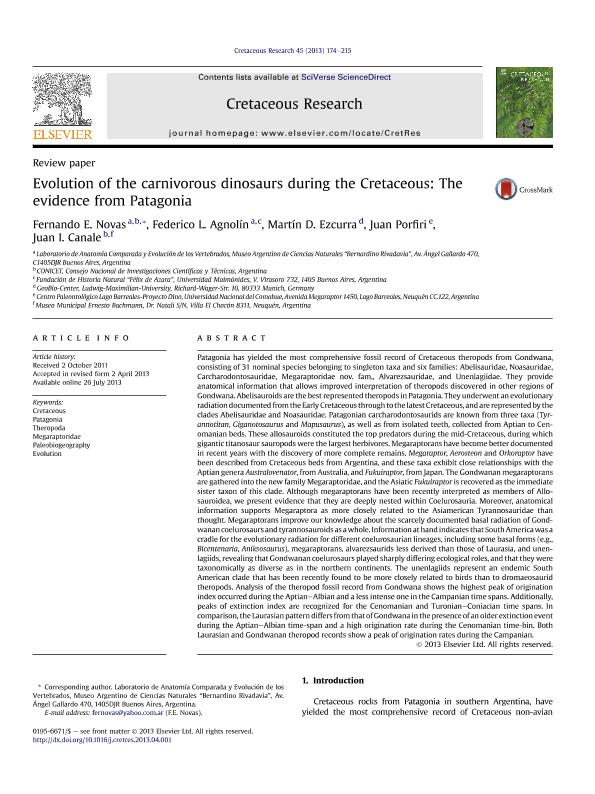Artículo
Evolution of the carnivorous dinosaurs during the Cretaceous: The evidence from Patagonia
Novas, Fernando Emilio ; Agnolin, Federico
; Agnolin, Federico ; Ezcurra, Martin Daniel
; Ezcurra, Martin Daniel ; Porfiri, Juan Domingo; Canale, Juan Ignacio
; Porfiri, Juan Domingo; Canale, Juan Ignacio
 ; Agnolin, Federico
; Agnolin, Federico ; Ezcurra, Martin Daniel
; Ezcurra, Martin Daniel ; Porfiri, Juan Domingo; Canale, Juan Ignacio
; Porfiri, Juan Domingo; Canale, Juan Ignacio
Fecha de publicación:
10/2013
Editorial:
Academic Press Ltd - Elsevier Science Ltd
Revista:
Cretaceous Research
ISSN:
0195-6671
Idioma:
Inglés
Tipo de recurso:
Artículo publicado
Clasificación temática:
Resumen
Patagonia has yielded the most comprehensive fossil record of Cretaceous theropods from Gondwana, consisting of 31 nominal species belonging to singleton taxa and six families: Abelisauridae, Noasauridae, Carcharodontosauridae, Megaraptoridae nov. fam., Alvarezsauridae, and Unenlagiidae. They provide anatomical information that allows improved interpretation of theropods discovered in other regions of Gondwana. Abelisauroids are the best represented theropods in Patagonia. They underwent an evolutionary radiation documented from the Early Cretaceous through to the latest Cretaceous, and are represented by the clades Abelisauridae and Noasauridae. Patagonian carcharodontosaurids are known from three taxa (Tyrannotitan, Giganotosaurus and Mapusaurus), as well as from isolated teeth, collected from Aptian to Cenomanian beds. These allosauroids constituted the top predators during the mid-Cretaceous, during which gigantic titanosaur sauropods were the largest herbivores. Megaraptorans have become better documented in recent years with the discovery of more complete remains. Megaraptor, Aerosteon and Orkoraptor have been described from Cretaceous beds from Argentina, and these taxa exhibit close relationships with the Aptian genera Australovenator, from Australia, and Fukuiraptor, from Japan. The Gondwanan megaraptorans are gathered into the new family Megaraptoridae, and the Asiatic Fukuiraptor is recovered as the immediate sister taxon of this clade. Although megaraptorans have been recently interpreted as members of Allosauroidea, we present evidence that they are deeply nested within Coelurosauria. Moreover, anatomical information supports Megaraptora as more closely related to the Asiamerican Tyrannosauridae than thought. Megaraptorans improve our knowledge about the scarcely documented basal radiation of Gondwanan coelurosaurs and tyrannosauroids as a whole. Information at hand indicates that South America was a cradle for the evolutionary radiation for different coelurosaurian lineages, including some basal forms (e.g., Bicentenaria, Aniksosaurus), megaraptorans, alvarezsaurids less derived than those of Laurasia, and unenlagiids, revealing that Gondwanan coelurosaurs played sharply differing ecological roles, and that they were taxonomically as diverse as in the northern continents. The unenlagiids represent an endemic South American clade that has been recently found to be more closely related to birds than to dromaeosaurid theropods. Analysis of the theropod fossil record from Gondwana shows the highest peak of origination index occurred during the Aptian–Albian and a less intense one in the Campanian time spans. Additionally, peaks of extinction index are recognized for the Cenomanian and Turonian–Coniacian time spans. In comparison, the Laurasian pattern differs from that of Gondwana in the presence of an older extinction event during the Aptian–Albian time-span and a high origination rate during the Cenomanian time-bin. Both Laurasian and Gondwanan theropod records show a peak of origination rates during the Campanian.
Palabras clave:
CRETACEOUS
,
PATAGONIA
,
THEROPODS
,
MEGARAPTORIDAE
,
PALEOBIOGEOGRAPHY
,
EVOLUTION
Archivos asociados
Licencia
Identificadores
Colecciones
Articulos(MACNBR)
Articulos de MUSEO ARG.DE CS.NAT "BERNARDINO RIVADAVIA"
Articulos de MUSEO ARG.DE CS.NAT "BERNARDINO RIVADAVIA"
Citación
Novas, Fernando Emilio; Agnolin, Federico; Ezcurra, Martin Daniel; Porfiri, Juan Domingo; Canale, Juan Ignacio; Evolution of the carnivorous dinosaurs during the Cretaceous: The evidence from Patagonia; Academic Press Ltd - Elsevier Science Ltd; Cretaceous Research; 45; 10-2013; 174-215
Compartir
Altmétricas



